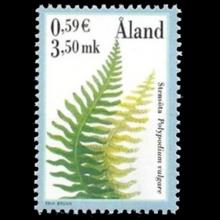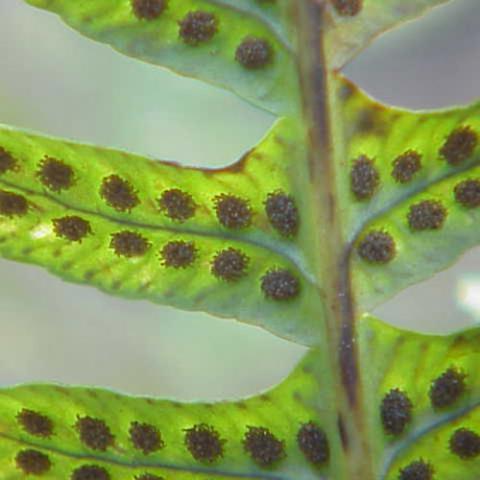NAME(S)
TAXONOMY
PLANTAE ID
THERAPEUTIC
Åland
Issued:
Stamp:
Polypodium vulgare
Åland
Issued:
Stamp:
Polypodium vulgare
Åland
Issued:
Stamp:
Polypodium vulgare
Genus species (Plantae): Polypodium vulgare
Polypodium vulgare, the common polypody, is a fern of the family Polypodiaceae. Polypodium vulgare is an allotetraploid species, believed to have arisen by chromosome doubling of a sterile diploid hybrid between two ferns which are not known in Europe. The fern's proposed parents are the northern Asian and northern North American Polypodium sibiricum and western North American Polypodium glycyrrhiza.[1] Biochemical data point to a species from eastern Asia as the second possible parent. The name is derived from poly (many) and pous, podos (a foot). Polypody has traditional uses in cooking for its aroma and sweet taste, and in herbal medicine as a purgative and vermifuge.
Description
Polypodium vulgare, the common polypody, is a fern developing in isolation from along a horizontal rhizome. The fronds with triangular leaflets measure 10 to 50 centimetres (3.9 to 19.7 in). They are divided all the way back to the central stem in 10 to 18 pairs of segments or leaflets.
The leaflets become much shorter at the end of the frond. The leaflets are generally whole or slightly denticulated and somewhat wider at their base, where they often touch each other. They have an alternating arrangement, those on one side being slightly offset from those on the other side. The petioles have no scales.
The sori are found on the lower side of the fronds and range in color from bright yellow to orange. They became dark grey at maturity.
- Period of sporulation: July to September.
- Mode of dissemination: anemochory (wind dispersal).
Geographical Distribution
The common polypody occurs throughout western Europe and North Africa. It is very common in France, where it is found up to an altitude of 2,000 meters (6,600 ft). It is also quite common in Scandinavia and Carpathian Mountains. It is an introduced species in New Zealand, that has begun to spread into the wild as an invasive species.
Uses
In cooking: The rhizome has a bittersweet taste. It has traditionally been used in some confectionery such as nougat for its aromatic properties. In 1971, a saponin, osladin was found in the roots and believed to be the compound responsible for the sweet taste as it elicits a relative sweetness 500 times sweeter than sugar (by weight).
Medicinal: The dried rhizome is used in herbal medicine as a purgative and vermifuge; these properties are due to the phytoecdysteroids in the rhizome.
Reference: Wikipedia




